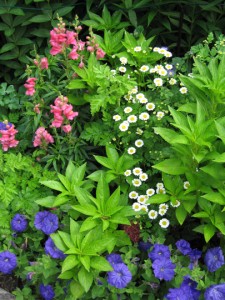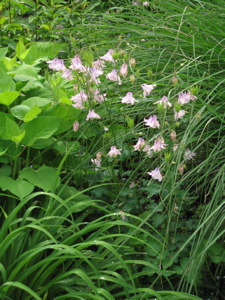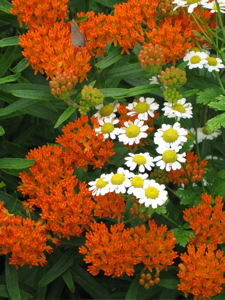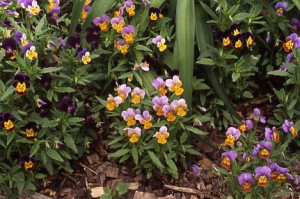Let Self-Sowers Do the Work for You
September 24, 2009 by admin
Filed under Cottage Gardening
What is it that gives cottage gardens their special joie de vivre? It’s a question I explore in depth in my new lecture, A Connecticut Cottage Garden: Adapting a Classic Garden Style to the Northeast. (Click here for my lecture schedule.)

Cottage gardens feature many kinds of delightfully intermingled plants.
The answer to the question actually has many parts. First, cottage gardens are packed with plants. That’s right—they’re just plain crowded, with plants tumbling over one another in a free-for-all attempt to reach the light.
Variety, too, is important. I once estimated that a small cottage garden I made had about 150 different kinds of plants.
So, it’s no wonder that cottage gardens seem to burst with life, or that there’s always something new happening. Put enough plants, and enough different plants, together in one place, and an overflowing, ever changing garden is practically inevitable.
But that’s not quite the whole story. Part of the cottage garden look is a certain accidental-on-purpose feel they have. But how to create that effect?
Funny as it sounds to say, “accidental-on-purpose” is actually not that hard to do. The key is self-sowing plants.
The term “self-sowing plant” is pretty self-explanatory. It’s a plant that spreads more or less readily by seed. It can be annual or biennial or even perennial, although most effective self-sowers fit into the first two categories just because annuals and biennials bloom a short time after germinating, whereas many perennials have to be 2-3 years old before they start flowering.

A self-sown columbine looks perfect where it chose to grow.
The magic of self-sowing plants is that they decide where they’ll grow. More than once, I’ve had the experience of finding a self-sown plant in a spot where it looks perfect (although I had nothing to do with it being there), and I’ve wondered, “Why didn’t I think of that?” It’s humbling.
On a more quotidian level, self-sowers are great because they’re huge time and work savers. Think how much effort it would take to start 200 foxglove seedlings in pots and then transplant them all into the garden individually. But by spreading foxglove seed in the garden, I might easily get hundreds of plants the following year with nothing more than a few minutes of time expended.
After the first generation of plants is established, they’ll distribute their seed throughout the garden with no further help from me, eventually giving rise to a stable population of plants that replace themselves as parent plants die out. If they propagate themselves a little too enthusiastically, I always have the option of culling seedlings, but that’s a lot easier than germinating and planting them.
How else do self-sowing plants make a gardener’s life easier? Well, think about the spots that are just too hard to plant manually, such as the joints between flagstones. Self-sowers can fill these tiny nooks and crannies easily—you just have to be patient. And again, when something inappropriate comes up—say, a five-foot plant in the middle of a narrow pathway—you can remove it.
At their best, self-sowers represent the combination of the gardener’s genius and the garden’s genius: the gardener provides the raw material and the garden runs with it, but the gardener always gets the last word.

Forget-me-not is a classic cottage garden self-sower.
Many classic cottage garden plants are self-sowers. Honesty (Lunaria, also called “money plant”), foxglove (Digitalis), columbine (Aquilegia), flowering tobacco (Nicotiana), feverfew (Tanacetum parthenium, which I prefer in the gold-leaved form ‘Aureum’), Johnny jump-ups (Viola tricolor) and forget-me-not (Myosotis sylvatica) are just a few examples.
Late summer and early autumn is the perfect time to spread seed of most self-sowing plants. It makes sense, because if the plants were already growing in your garden, now is when their seed would be maturing. The seeds of annuals may not start growing until next spring, but getting them in the garden now is a good idea because they’ll be perfectly positioned to take advantage of late winter’s abundant moisture to get them off to a good start.
Biennials probably will germinate now and produce a bit of leafy growth before hunkering down for the winter. In fact, this autumn’s growth will count as their “first year,” so they’ll flower next spring or summer even though they’re less than two years old by the calendar. This is why biennials will flower in your garden every year rather than every other year once they’re established; their age is measured in growing seasons, not calendar years.
If you’ve never grown self-sowing plants before, there are a couple of things you’ll have to get used to. Because most good self-sowers are annuals or biennials, they tend to move around a lot. An annual or biennial parent plant dies off after one or two seasons, and its offspring come up where they will. In many gardens, it would be an annoyance if a plant picked up and moved. In a cottage garden, it’s just charming.

I always put golden feverfew next to butterfly weed if it doesn't seed itself there.
Besides, you can always move a few seedlings if you have your heart set on a plant growing in a particular spot. I do this as needed with golden feverfew, because I always want some growing next to my Ligularia przewalskii, my daylily (Hemerocallis) ‘Bertie Ferris’ and my butterfly weed (Asclepias tuberosa). You’ll discover your own favorite combinations.
Also, you can’t predict just how much of a self-sowing plant you’ll have in any given year. Depending on weather and other conditions, you might have very few specimens of a particular plant one year and a population explosion the next. I’ve learned to accept that sometimes there’s no point trying to figure out why—only the plant knows what motivates it.
Other plants will be consistently abundant. In that case, it’s important to draw a line between unstructured and chaotic in the garden. Be ruthless in removing excess seedlings, or you may regret it later. Morning glory became unmanageable in one of my gardens, and I banished it (although that task took several years). Remember, you’re trying to save yourself work, not create more of it. Deal with problem plants before the situation gets out of hand.
Conversely, a plant you treasure may never self-sow as much as you want in your garden. In that case, just help it along by strewing some additional seed each autumn. I have to do that with foxglove in one garden I keep or it will eventually die out.
There’s one last point I want to make about self-sowing plants, and that’s that they aren’t appropriate in every setting. Non-native self-sowing plants shouldn’t be used where they are likely to escape into the wild. That means keeping them away from uncultivated areas and other people’s property.
I once read an article about a self-sown urban front yard garden. I hope the author’s neighbors had the same taste he did, because it’s 100% certain that they got some of his plants. So be courteous and responsible when deciding to use self-sowers—they can become a nuisance to other people and/or a problem in the environment. I think it’s just a matter of ecological responsibility and neighborliness.
So get a head start on next year by experimenting with a few self-sowing plants in your cottage garden. Below is a list of some good candidates that shouldn’t be too hard to find in seed form. I encourage you to try several to increase your chances of success. Don’t be disappointed if a few don’t work. The essence of the cottage gardening spirit is letting the garden express its personality, too. Love what works, and let what doesn’t go.

Johnny jump-ups fill in garden nooks and crannies all by themselves.
Columbine (Aquilegia)
Spider flower (Cleome hassleriana)—Potentially invasive, so thin it out if necessary.
Larkspur (Consolida)
Cosmos (Cosmos bipinnatus and C. sulphureus)
California poppy (Eschscholzia californica)—Prefers dry conditions.
Sunflower (Helianthus annuus)
Balsam impatiens (Impatiens balsamina)
Sweet alyssum (Lobularia maritima)
Honesty (Lunaria annua)
Forget-me-not (Myosotis sylvatica)—Potentially invasive, even in wooded areas. Will form a low carpet of flowers in May.
Perilla (Perilla frutescens)—Potentially invasive; deadhead at least some of the crop to keep it under control-you’ll grow this for its purple leaves, anyway.
Poppies (various Papaver)
Johnny jump-up (Viola tricolor)


I will certainly vouch for cosmos as a self-seeder. With all the rain this year, three attempts to start cosmos from seed failed, however I had enough self-seeders in the garden and lawn to save the season! Even at the two-leaf stage they are recognizable, once you know what to look for. Cosmos are a mainstay in my bouquets starting in August, and I pair them up in my arrangements with dahlias, which are just a superb plant in the garden, also starting in August and lasting until frost. So many people complain that their gardens look forlorn in August & September, but for me that’s the peak in my garden: cosmos, dahlias, asters, boltonia — and my veronica and Queen Anne’s Lace are still going strong, too!